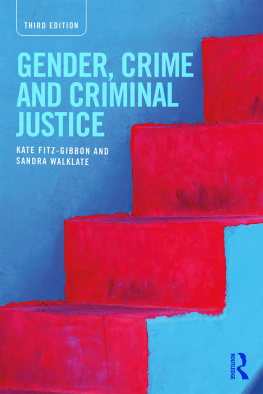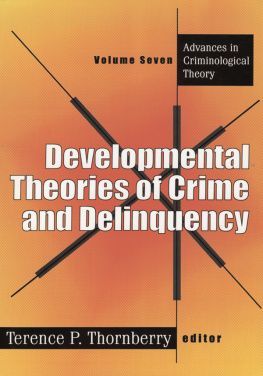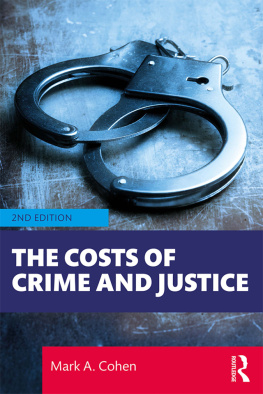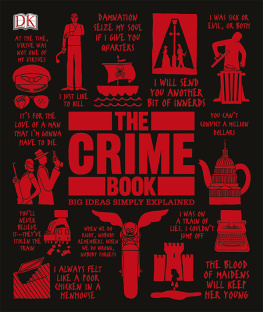CLINARD AND QUINNEYS CRIMINAL BEHAVIOR SYSTEMS
An important classic, familiar to virtually all criminologists, Clinard and Quinneys Criminal Behavior Systems: A Revised Edition begins with a discussion of the construction of types of crime and then formulates and utilizes a useful typology of criminal behavior systems. It classifies crime into seven categories, among them: violent personal crime, occasional property crime, public order crime, occupational crime, corporate crime, organized crime, and political crime. They examine the criminal career of the offender in each category, public and legal attitudes toward these individuals, support systems they may have, attitudes of the offenders, and other features. The discussion of each category of crime is thorough and enlightening and takes the reader far in understanding the huge problem of crime and establishing intelligent definitions to study it.
The new edition looks at the criminal landscape of the twenty-first century, capturing both the numerous advancements in theory and research in the field of criminology, as well as many societal changes that have taken place in law, mass media, the economy, culture, and the political system that directly affect the books coverage of various types of crimes. A global perspective broadens the books relevance to include a variety of different societies. Crimes newly examined in this edition include identity theft, domestic violence, arson, hate crimes, cybercrime, campus sexual assault, police brutality, Ponzi schemes, human trafficking, and terrorism. Finally, alternatives to conventional criminal justice are considered, including such approaches as peacemaking, restorative justice, private justice, problem solving, harm reduction, naming and shaming, and internal and external controls.
Like its predecessors, Clinard and Quinneys Criminal Behavior Systems: A Revised Edition will be essential to criminologists formulating their own theories and research on criminal behavior as well as to students in criminology and sociology courses on how to view and study crime.
A. Javier Trevio is Professor of Sociology at Wheaton College. He is the author and editor of several books including The Social Thought of C. Wright Mills (2012); Classic Writings in Law and Society, Second Edition, Revised and Expanded (2010); Talcott Parsons on Law and the Legal System (2008); George C. Homans: History, Theory, and Method (2006); Understanding Crime: A Multidisciplinary Approach (edited with Susan Guarino-Ghezzi) (Anderson Publishing, 2005); Goffmans Legacy (2003); Talcott Parsons Today: His Theory and Legacy in Contemporary Sociology (2001); and The Sociology of Law: Classical and Contemporary Perspectives (1996). He received his Ph.D. from Boston College, his M.A. from Northern Arizona University, and his B.A. from the University of North Texas. He has served as President of the Justice Studies Association (20002002), President of the Society for the Study of Social Problems (20102011), and was a Fulbright Scholar to the Republic of Moldova (2009).
Richard Quinney is a renowned American sociologist, writer, and photographer known for his philosophical and critical approach to crime and social justice. After earning his Ph.D. in Sociology from the University of Wisconsin, he taught at several universities on the East Coast and in the Midwest. He is author of several books, including Criminal Behavior Systems (first published in 1967), The Problem of Crime (1970), The Social Reality of Crime (1974), Critique of Legal Order (1974), Criminology (1975), Class, State, and Crime (1977), Providence (1980), Social Existence (1982), Criminology as Peacemaking (1991), Erich Fromm and Critical Criminology (2000), Bearing Witness to Crime and Social Justice (2000), and Storytelling Sociology (2004). He was awarded the prestigious Edwin Sutherland Award in 1984 by the American Society of Criminology for his contributions to criminological theory. He is currently Professor Emeritus of Sociology at Northern Illinois University.
The late Marshall B. Clinard was Quinneys coauthor on the first, second, and third editions of Criminal Behavior Systems . The late John Wildeman joined them on the third edition.
by Routledge
52 Vanderbilt Avenue, New York, NY 10017
and by Routledge
2 Park Square, Milton Park, Abingdon, Oxon, OX14 4RN
Routledge is an imprint of the Taylor & Francis Group, an informa business
2019 Taylor & Francis
The right of A. Javier Trevio to be identified as author of this work has been asserted by him in accordance with sections 77 and 78 of the Copyright, Designs and Patents Act 1988.
All rights reserved. No part of this book may be reprinted or reproduced or utilised in any form or by any electronic, mechanical, or other means, now known or hereafter invented, including photocopying and recording, or in any information storage or retrieval system, without permission in writing from the publishers.
Trademark notice : Product or corporate names may be trademarks or registered trademarks, and are used only for identification and explanation without intent to infringe.
First edition published by Holt, Rinehart and Winston, Inc. 1967
Third edition published by Anderson Publishing Co. 1994
Library of Congress Cataloging-in-Publication Data
A catalog record has been requested for this book
ISBN: 978-0-367-02664-6 (hbk)
ISBN: 978-0-367-02665-3 (pbk)
ISBN: 978-0-429-39846-9 (ebk)
Typeset in Bembo
by Swales & Willis Ltd, Exeter, Devon, UK
Richard Quinney
A long time agowhen the world was newI asked Marshall Clinard what he thought about creating a typology of criminal behavior. As a graduate student in sociology at the University of Wisconsin at the end of the 1950s, I had read his Sociology of Deviant Behavior and been impressed by his delineation of types of delinquent and criminal behavior based on a continuum of the careers of offenders. This was a time when several sociologists were constructing typologies of various kinds. I had studied with Howard P. Becker and was working on a dissertation under his direction when he died unexpectedly in the summer of 1960, as I was about to leave for my first teaching job, at St. Lawrence University. Marshall was returning from research in India, and before I left I asked him to be the advisor for my dissertation. He agreed. Thus my turn from social theory, with emphasis on the sociology of knowledge and religion, to criminology.
Obviously, there was something about the construction of typologies that appealed to my intellectual interests. While studying with Becker, I had been inspired by his constructed types of sacred and secular. He had elaborated the constructive process in articles and books, especially in Social Thought from Lore to Science . Eventually, the many efforts in typology construction would be presented and analyzed in John McKinneys Constructive Typology and Social Theory (1966). By then, I had completed my dissertation and moved to teaching jobs, first at the University of Kentucky and then at New York University. During those years, Marshall and I had been writing what would be the first edition of our Criminal Behavior Systems: A Typology (1967).
Marshall and I kept in contact and were colleagues and friends for 50 years, until his death in 2010 at the age of 98. There would be a second and a third edition of Criminal Behavior Systems . You could say that it was this book that was the thread that held us together. But certainly there was more: frequent visits over these years, travel together to India and Kathmandu, letter exchanges now comprising a thick file in a drawer beside my desk, reading and commenting on books that we wrote individually, and advice and encouragement to each other along the way. This revision of our book brings us together one more timegood fortune in the guise of an academic life.











